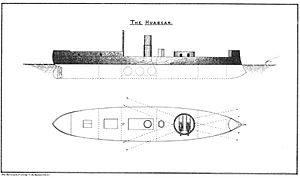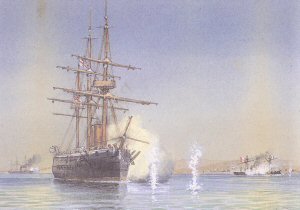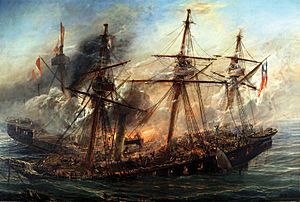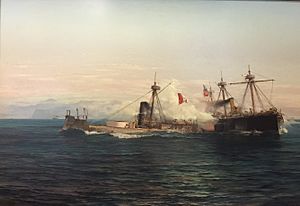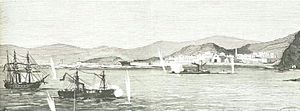Huáscar (ironclad) facts for kids
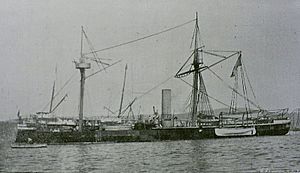
Huáscar in 1903
|
|
Quick facts for kids History |
|
|---|---|
| Name | Huáscar |
| Ordered | 4 August 1864 |
| Builder | Laird Brothers, Birkenhead, England |
| Launched | 7 October 1865 |
| Commissioned | 8 November 1866 |
| Captured | Captured by Chile at the Battle of Angamos, 8 October 1879 |
| Acquired | 8 October 1879 |
| Decommissioned | 1897 |
| Reinstated | 1934 |
| Status | Museum ship |
| General characteristics | |
| Type | Ironclad turret ship |
| Displacement | 1,870 long tons (1,900 t) |
| Length | 66.9 m (219 ft 6 in) |
| Beam | 10.9 m (35 ft 9 in) |
| Draught | 5.7 m (18 ft 8 in) |
| Installed power | |
| Propulsion | 1 × screw; 1 × Horizontal-return connecting rod-steam engine |
| Sail plan | Brig-rigged |
| Speed | 12 knots (22 km/h; 14 mph) |
| Complement | 170 |
| Armament | *list error: list item missing markup (help)
|
| Armour |
|
The Huáscar is a famous warship that was built in 1865. It's a special type of ship called an ironclad turret ship. This means it was covered in thick metal armor and had its main guns in a spinning tower called a turret.
The ship was first built for the Peruvian government. It was named after Huáscar, an ancient Inca emperor. The Huáscar was the main ship of the Peruvian Navy for a while. It took part in important battles, like the Battle of Pacocha and the War of the Pacific (1879–1883).
During the Battle of Angamos in 1879, the Huáscar was led by a brave Peruvian naval officer named Miguel Grau Seminario. However, the ship was captured by the Chilean fleet. After that, it became part of the Chilean Navy.
Today, the Huáscar is one of the very few ships of its kind that still exists. It has been carefully restored and is now a museum ship. You can visit it in Talcahuano, Chile. It's the second oldest armored warship that can still float, after Warrior. It's also the oldest type of warship called a monitor that is still afloat.
Contents
What Makes Huáscar Special?
The Huáscar was a very advanced ship for its time. It was designed by Captain Cowper Phipps Coles, a British naval officer. He described it as a "sea-going vessel" that was 1,100 tons and could travel at 12.25 knots (about 22.7 kilometers per hour).
The ship had a special mast design with tripods. It carried two powerful 300-pound guns in its single turret. These guns could fire straight ahead.
The British magazine Engineering also described the Huáscar when it was built. They said it was an "armour-clad monitor" built by Laird Brothers in 1866. It was about 57.9 meters (190 feet) long. Its sides were protected by armor that was 11.4 centimeters (4.5 inches) thick in the middle. The gun turret had even thicker armor, about 14 centimeters (5.5 inches) thick. The ship also had a special armored tower for the pilot, which helped control the ship during battles.
Early Years and Challenges
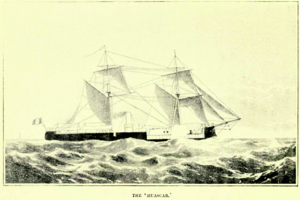
The Peruvian government ordered the Huáscar from a British shipbuilder in 1864. This was during the Chincha Islands War against Spain. The ship cost a bit more than £81,000. It was launched in Birkenhead on October 7, 1865.
The Huáscar began its journey to Peru on January 20, 1866. The trip was quite difficult. It had to wait a month in France and had a small collision with another ship. Neutral countries refused to help it, and it needed a month of repairs in Brazil. By the time it reached Chile on June 7, it was too late to join the war.
In February 1868, a Peruvian naval officer named Miguel Grau took command of the Huáscar. He stayed in command until 1876. He became the ship's longest-serving commander. His many years on the ironclad made him very skilled. He later became Peru's most famous naval officer.
The Peruvian Civil War
The Huáscar was involved in a Nicolás de Piérola's attempt to overthrow the Peruvian government in 1877. On May 6, some of de Piérola's supporters took control of the Huáscar at the port of Callao. The ship then sailed away with Luis Germán Astete in command.
The rebels used the Huáscar to cause trouble for government forces and shipping. This also affected foreign ships. Because of this, British warships got involved.
On May 29, 1877, the Huáscar fought the Battle of Pacocha against two British ships. These were the frigate HMS Shah and the corvette HMS Amethyst. This battle was important because it was the first time a self-propelled torpedo was used in combat. The Huáscar surrendered to the government after being in rebel hands for almost a month.
The War of the Pacific
The Huáscar played a big role in the War of the Pacific (1879–1883). It was still under the command of Captain Grau. The ship became famous for its brave attacks on Chilean ports and transport ships. Because of the Huáscar's actions, Chile's ground invasion was delayed for almost six months. The Chilean fleet had to find and stop the Huáscar first.
On May 21, 1879, the Huáscar helped break the Chilean blockade of Iquique. During the Battle of Iquique, the Chilean captain, Arturo Prat, was killed on the Huáscar's deck. After sinking the Chilean ship Esmeralda, the Huáscar rescued the survivors.
For the next 137 days, the Huáscar avoided the enemy fleet. It also made the coast unsafe for Chilean transport ships. Its biggest capture was the Chilean transport ship Rímac. This ship was carrying 260 cavalry soldiers.
Chile was determined to protect its supply lines for the invasion of Peru. So, they sent every available ship to hunt down the Huáscar. On October 8, 1879, the Huáscar was captured by the Chilean Navy at the Battle of Angamos. During this battle, Rear Admiral Grau and 32 of his crew were killed.
Continuing the War
After being captured at the Battle of Angamos, the Huáscar joined the Chilean Navy. It fought at Arica, where it had a duel with the Peruvian monitor Manco Cápac. It also helped bombard the city of Arica. Its new commander, Manuel Thomson, was killed during this time. The Huáscar also helped blockade the port of Callao.
After the War
After the war, the Huáscar was updated in 1885 and 1887. It received new boilers and steam engines. These new engines helped move its guns and turrets.
In May 1888, the Huáscar carried the bodies of the officers from the Esmeralda (the ship it sank at Iquique). They were moved from Iquique to a new burial place in Valparaíso. Rear Admiral Luis Uribe, who had survived the Battle of Iquique, was in charge of this ceremony.
The Chilean Civil War
The Huáscar was involved in the 1891 Chilean Civil War. This was a fight between the government and the congress. The ship was undergoing major repairs when the war started. However, the rebel navy quickly took it from Valparaíso and got it ready for battle in just three days.
Under Captain José María Santa Cruz, the Huáscar helped the rebels take over the port city of Taltal. It also protected rebel convoys and ports. It even returned to Iquique to bombard the city, which was held by government forces. The war ended after almost eight months of fighting, with the government surrendering.
Later Years and Preservation
The Huáscar continued to serve the Chilean Navy until 1897. A boiler explosion at the Talcahuano military harbor led to its retirement from active service. It was partially repaired and later served as the first submarine tender for the Chilean Navy from 1917 to 1930.
In the early 1930s, work began to restore the Huáscar as a heritage ship. It was brought back into service in 1934, but as a museum. It was armed with different guns, including two 8-inch guns.

Between 1951 and 1952, a big effort was made to fully restore the Huáscar to how it looked in 1897. The goal was to make it a special place honoring both the Peruvian and Chilean navies.
It became a floating museum and a memorial. It displays many items and relics found in Navy warehouses or donated by people. These include:
- A special area with pictures of the three commanders who died on its deck.
- A gallery of portraits in the boiler room.
- A prayer room, approved by the Archbishop of Concepción.
More restoration work happened between 1971 and 1972. The ship's hull was fully repaired, and its engines were rebuilt using original plans from England. Since then, a careful maintenance program has kept the ship preserved for future generations.
In 1995, the World Ship Trust gave the Chilean Navy an award for restoring the Huáscar. The Huáscar is docked at the port of Talcahuano, Chile. In 2010, a big earthquake and tsunami hit the area. Even though the Huáscar was at the base, it survived with no damage. It reopened to visitors in March 2011.
Why Huáscar is Important
The Huáscar is one of the few early ironclad warships that is still floating today. It is highly respected in both Peru and Chile. It is seen as a memorial to brave naval officers like Peru's Admiral of the Fleet Miguel Grau Seminario and Chile's Captains Arturo Prat and Manuel Thomson, who all died on its decks.
See also
 In Spanish: Monitor Huáscar para niños
In Spanish: Monitor Huáscar para niños


